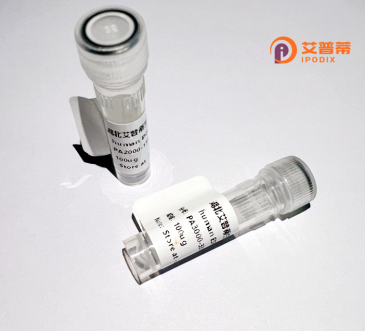
| 纯度 | >90%SDS-PAGE. |
| 种属 | Human |
| 靶点 | RER1 |
| Uniprot No | O15258 |
| 内毒素 | < 0.01EU/μg |
| 表达宿主 | E.coli |
| 表达区间 | 1-196 aa |
| 活性数据 | MSEGDSVGESVHGKPSVVYRFFTRLGQIYQSWLDKSTPYTAVRWVVTLGLSFVYMIRVYLLQGWYIVTYALGIYHLNLFIAFLSPKVDPSLMEDSDDGPSLPTKQNEEFRPFIRRLPEFKFWHAATKGILVAMVCTFFDAFNVPVFWPILVMYFIMLFCITMKRQIKHMIKYRYIPFTHGKRRYRGKEDAGKAFAS |
| 分子量 | 47.19 kDa |
| 蛋白标签 | GST-tag at N-terminal |
| 缓冲液 | PBS, pH7.4, containing 0.01% SKL, 1mM DTT, 5% Trehalose and Proclin300. |
| 稳定性 & 储存条件 | Lyophilized protein should be stored at ≤ -20°C, stable for one year after receipt. Reconstituted protein solution can be stored at 2-8°C for 2-7 days. Aliquots of reconstituted samples are stable at ≤ -20°C for 3 months. |
| 复溶 | Always centrifuge tubes before opening.Do not mix by vortex or pipetting. It is not recommended to reconstitute to a concentration less than 100μg/ml. Dissolve the lyophilized protein in distilled water. Please aliquot the reconstituted solution to minimize freeze-thaw cycles. |
以下是关于重组人RER1蛋白的3条代表性文献概览,涵盖其功能及机制研究:
---
1. **文献名称**:*RER1 regulates the retention of the unfolded protein response sensor ATF6 in the Golgi apparatus*
**作者**:Saito, K. et al.
**摘要**:研究发现RER1蛋白通过调控内质网-高尔基体间转运,参与未折叠蛋白响应(UPR)传感器ATF6的定位,影响内质网应激应答。其缺失会破坏ATF6在高尔基体的保留,导致UPR信号异常。
2. **文献名称**:*RER1 deficiency in mice leads to impaired dendritic cell homeostasis and altered cytokine production*
**作者**:Kanemoto, S. et al.
**摘要**:通过小鼠模型揭示RER1在免疫系统中的调控作用,发现RER1缺陷引发树突状细胞稳态紊乱,影响IL-6等细胞因子的分泌,提示其在免疫疾病中的潜在作用。
3. **文献名称**:*Role of RER1 in COPII vesicle formation and cargo selection during ER-Golgi transport*
**作者**:Munakata, S. et al.
**摘要**:经典研究阐明RER1作为COPII复合体的辅助因子,选择性调控特定跨膜蛋白(如SERCA2)的运输,确保内质网稳态及蛋白质分选的精确性。
---
**备注**:以上为概要总结,建议通过PubMed或Google Scholar检索具体文献,结合实验需求选择研究方向(如内质网运输、疾病机制等)。若需扩展,可补充阿尔茨海默病中RER1与γ-分泌酶复合体互作的研究。
RER1 (Retention in endoplasmic reticulum protein 1) is a conserved transmembrane protein predominantly localized in the endoplasmic reticulum (ER) and cis-Golgi compartments. It plays a critical role in quality control of secretory pathway proteins by mediating the retrieval of misfolded or unassembled proteins from the Golgi back to the ER for proper folding, degradation, or recycling. This selective retrograde transport is achieved through its interaction with coatomer protein complex I (COPI) vesicles, which recognizes specific sorting signals in cargo proteins, such as ER retention motifs.
Originally identified in yeast, mammalian RER1 has been implicated in regulating the trafficking of diverse substrates, including neurotransmitter receptors, ion channels, and γ-secretase complex components. Its dysfunction is linked to neurodegenerative disorders, including Alzheimer's disease, where altered RER1 activity may disrupt amyloid precursor protein (APP) processing. Structurally, RER1 contains multiple transmembrane domains and luminal/cytoplasmic regions for cargo recognition and vesicle coat binding.
Research on RER1 continues to uncover its roles in maintaining cellular homeostasis, ER stress responses, and disease mechanisms, positioning it as a potential therapeutic target for protein-misfolding disorders. Its conserved function across eukaryotes highlights its fundamental importance in membrane protein quality control.
×